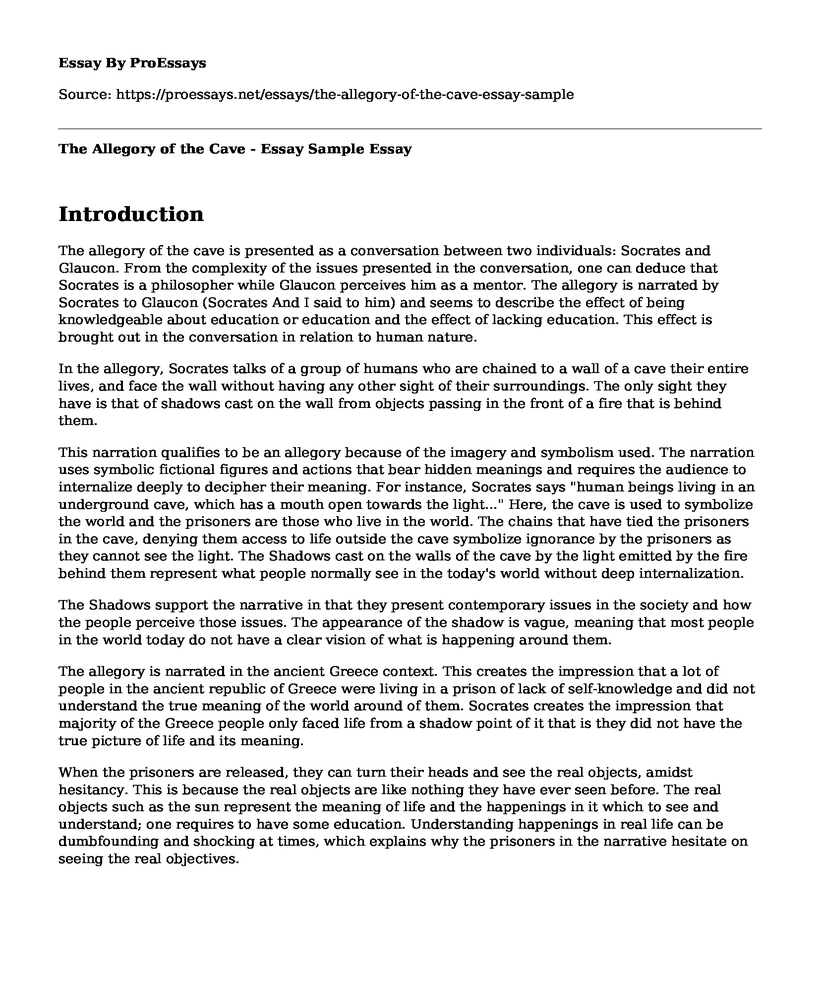Introduction
The allegory of the cave is presented as a conversation between two individuals: Socrates and Glaucon. From the complexity of the issues presented in the conversation, one can deduce that Socrates is a philosopher while Glaucon perceives him as a mentor. The allegory is narrated by Socrates to Glaucon (Socrates And I said to him) and seems to describe the effect of being knowledgeable about education or education and the effect of lacking education. This effect is brought out in the conversation in relation to human nature.
In the allegory, Socrates talks of a group of humans who are chained to a wall of a cave their entire lives, and face the wall without having any other sight of their surroundings. The only sight they have is that of shadows cast on the wall from objects passing in the front of a fire that is behind them.
This narration qualifies to be an allegory because of the imagery and symbolism used. The narration uses symbolic fictional figures and actions that bear hidden meanings and requires the audience to internalize deeply to decipher their meaning. For instance, Socrates says "human beings living in an underground cave, which has a mouth open towards the light..." Here, the cave is used to symbolize the world and the prisoners are those who live in the world. The chains that have tied the prisoners in the cave, denying them access to life outside the cave symbolize ignorance by the prisoners as they cannot see the light. The Shadows cast on the walls of the cave by the light emitted by the fire behind them represent what people normally see in the today's world without deep internalization.
The Shadows support the narrative in that they present contemporary issues in the society and how the people perceive those issues. The appearance of the shadow is vague, meaning that most people in the world today do not have a clear vision of what is happening around them.
The allegory is narrated in the ancient Greece context. This creates the impression that a lot of people in the ancient republic of Greece were living in a prison of lack of self-knowledge and did not understand the true meaning of the world around of them. Socrates creates the impression that majority of the Greece people only faced life from a shadow point of it that is they did not have the true picture of life and its meaning.
When the prisoners are released, they can turn their heads and see the real objects, amidst hesitancy. This is because the real objects are like nothing they have ever seen before. The real objects such as the sun represent the meaning of life and the happenings in it which to see and understand; one requires to have some education. Understanding happenings in real life can be dumbfounding and shocking at times, which explains why the prisoners in the narrative hesitate on seeing the real objectives.
Conclusion
The message that we can deduce from this analogy today, 2500 years after it was narrated is that humans should be willing to seek wisdom and truth in life and approach life's issues with an open mind. The Allegory insists on the necessity of education in understanding issues that life brings along with it.
Cite this page
The Allegory of the Cave - Essay Sample. (2022, Jun 16). Retrieved from https://proessays.net/essays/the-allegory-of-the-cave-essay-sample
If you are the original author of this essay and no longer wish to have it published on the ProEssays website, please click below to request its removal:
- Rite Of Passage - Poem Amalysis Example
- Poetry Analysis Essay on Daystar by Rita Dove
- Essay Sample on Death of a Salesman: A Tragic Tale of Dignity and Imitation
- Solving the Case of Alex Using APA Ethical Principles - Essay Sample
- Essay Example on Here Come the Sun: Struggles of Life in Jamaica's River Bank
- Essay Sample on Ethical Principles: Defining Right and Wrong
- Essay Example on August Wilson: American Playwright and Chronicler of African American Struggles







